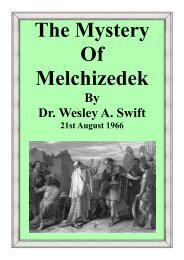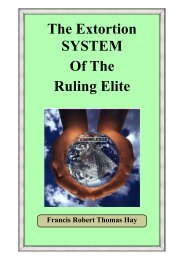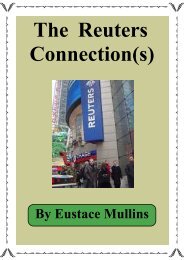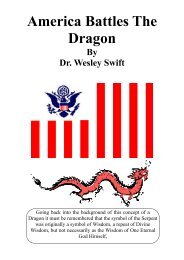Curse of Cannan - The New Ensign
Curse of Cannan - The New Ensign
Curse of Cannan - The New Ensign
Create successful ePaper yourself
Turn your PDF publications into a flip-book with our unique Google optimized e-Paper software.
is that St. Patrick expelled the serpents from Ireland. Both legends call attention to the demonic<br />
practices <strong>of</strong> the Canaanites, as well as their descent from the serpent; its banishment established<br />
Ireland as a land <strong>of</strong> the true religion <strong>of</strong> YHWH, or the descendants <strong>of</strong> Shem. <strong>The</strong> disappearance<br />
<strong>of</strong> the serpents also signified that the evil powers <strong>of</strong> the Canaanites had vanished from Ireland.<br />
Both Spain and Ireland show their direct connection to the descendants <strong>of</strong> Shem in their names.<br />
Spain occupies the Iberian Peninsula, from Iber, or Hebrew; Ireland is known 18 Hibernia, the<br />
land <strong>of</strong> the Hebrews, as are the Hebrides Islands. In his History <strong>of</strong> Ireland, Roger Chauvire says<br />
that Ireland is the last remaining part <strong>of</strong> Atlantis which is still above the surface <strong>of</strong> the sea. In<br />
his History <strong>of</strong> Ireland, A. M. Sullivan writes <strong>of</strong> the legendary origin <strong>of</strong> the present Irish race.<br />
"<strong>The</strong> Milesian colony reached Ireland from Spain, but they were not Spanish. <strong>The</strong>y were an<br />
eastern people who had tarried in that country on their way westward, seeking, they aid, an island<br />
promised to the posterity <strong>of</strong> their ancestor Gadelius. Gadelius was the son <strong>of</strong> Niul, who was the<br />
youngest son <strong>of</strong> the King <strong>of</strong> Scythia. As a child, Gadelius had been bitten by a poisonous serpent.<br />
He was near death when his father persuaded Moses to use his rod to cure him. From that day,<br />
the Milesians carried westward their banner, which was emblazoned with a dead serpent and the<br />
rod <strong>of</strong> Moses, until they found an island which had no poisonous snakes."<br />
<strong>The</strong> sons <strong>of</strong> Milesius, Gadelius' descendants, who sailed from Spain to Ireland were Heber the<br />
Fair, Amergin, Colpa, Heber the Brown, Ir, and Heremon. <strong>The</strong>ir descendants ruled Ireland for<br />
one thousand years, the dynasty being established by Niall (Niul), who ruled at Tara from 310<br />
to 405. He is described by Sullivan as "a splendid hero <strong>of</strong> the Gaelic blood, tall, fair-haired and<br />
blue-eyed, a great and noble-minded warrior, 'kind in hall and fierce in fray'; from him descended<br />
the kings <strong>of</strong> Ireland, the Neills."<br />
<strong>The</strong>se conquerors <strong>of</strong> Ireland, the Milesians, derived their name from Milesius, the soldier (from<br />
the Latin miles, from which we get the word militia). Gadelius, the founder <strong>of</strong> the line, derived<br />
his name from the Hebrew "gadil," meaning to become great, or in plural the exalted, the<br />
fortune-seekers, or the fortunate ones. Because <strong>of</strong> their great pride and their natural abilities, the<br />
Irish were later referred to as being from "the Land <strong>of</strong> Kings." Of almost any Irishman, it could<br />
be boastfully said, "Sure, and he's the descendant <strong>of</strong> kings."<br />
From earliest records, the Irish and the Britons are shown to be historic enemies. Apuleius wrote<br />
in 296 A.D. <strong>of</strong> the "two races, the Britons and Ibernia." Eumenius always wrote <strong>of</strong> Hibernia as<br />
the enemy <strong>of</strong> Briton. Caesar's Notes on the Gallic Wars, 58-50 B.C., wrote <strong>of</strong> "Hibernia, west<br />
<strong>of</strong> Britain."<br />
<strong>The</strong> world was now swept by two diametrically opposed tides <strong>of</strong> history. On the one hand were<br />
the highly creative and productive descendants <strong>of</strong> Shem, who have since become known as<br />
Semites, and on the opposing side were the "cursed Canaanites," who historically were the<br />
anti-Semites, the foes <strong>of</strong> the tall, fair-haired, and blue eyed descendants <strong>of</strong> Shem. Because the<br />
Semites were always known as great warriors, they handily defeated the Canaanites in every<br />
military encounter, and in many cases obeyed God's command to drive them out and to destroy<br />
them utterly. But the anti Semites seemed to have great staying power; when driven out <strong>of</strong> one<br />
country, they appeared in another to continue their same type <strong>of</strong> corruption and betrayal. While<br />
the Semites were busily establishing one great empire after another, Asshur's building the<br />
Assyrian Empire, Cyrus the Great building the Persian Empire, and Shem himself creating the<br />
great Egyptian civilization, the anti-Semites were developing their own talents. <strong>The</strong>se included<br />
a talent for trade and commerce, for travel, for making themselves at home in any country, and<br />
among any race <strong>of</strong> people. Generally they established their trading colonies along the seacoasts,<br />
for they lacked the courage to venture into the great wildernesses <strong>of</strong> Europe, where the Semites<br />
always made themselves at home. <strong>The</strong> Canaanites always remained true to the precepts <strong>of</strong> the<br />
Will <strong>of</strong> Canaan; they were true to each other, regardless <strong>of</strong> the circumstances; they were constant<br />
in their love <strong>of</strong> robbery, their love <strong>of</strong> lewdness, and their hatred <strong>of</strong> the masters, that is, anyone<br />
who tried to interfere with their corrupt way <strong>of</strong> life. And they always refused to tell the truth. By<br />
( Page 18)
















